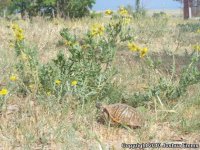| Range: |
 |
| Other Names: |
Box Tortoise |
| Description: |
High-domed carapace, not serrated posteriorly. Four toes on rear feet. Transverse hinge across plastron. Upper jaw with downturned "beak" without notch. Carapace dark brown or reddish brown often with yellow middorsal stripe. Conspicuous pattern of radiating yellow stripes on scutes, with dark seams. Plastron dark brown or tan; plastron with pattern of radiating lines. Skin brown with spots of yellow on limbs and head. Tail can have yellow stripe. Head can be greenish. Adult males with red iris; females with yellow-brown iris. The carapace length of an adult Terrapene ornata typically measures between 10-13 cm (4-5 in). |
| Similar Species: |
The closely related Desert Box Turtle can be distinguished by lighter coloring and range. They do integrade with themon the edge of their range. |
| Habitat: |
This box turtle species is generally restricted to the prairies devoid of trees and dominated by grass and low shrubs. |
| Behavior: |
A diurnal species, the ornate box turtle spends its day alternating between basking, feeding, and seeking shelter from the heat of the day. Shelter may be burrows in sandy soils or under fallen vegetation. Activity is often increased following summer rains and thunderstorms. |
| Hibernation: |
Underground during the cool months. |
| Reproduction: |
Nesting occurs in the late spring and summer. Clutch sizes range from 2-8 and two clutches may be laid each year. Incubation averages around 80 days. |
| Diet: |
Insects make up the majority of the diet in ornate box turtles. This species is also known to eat carrion, bird eggs, small vertebrates and even fruit. |







